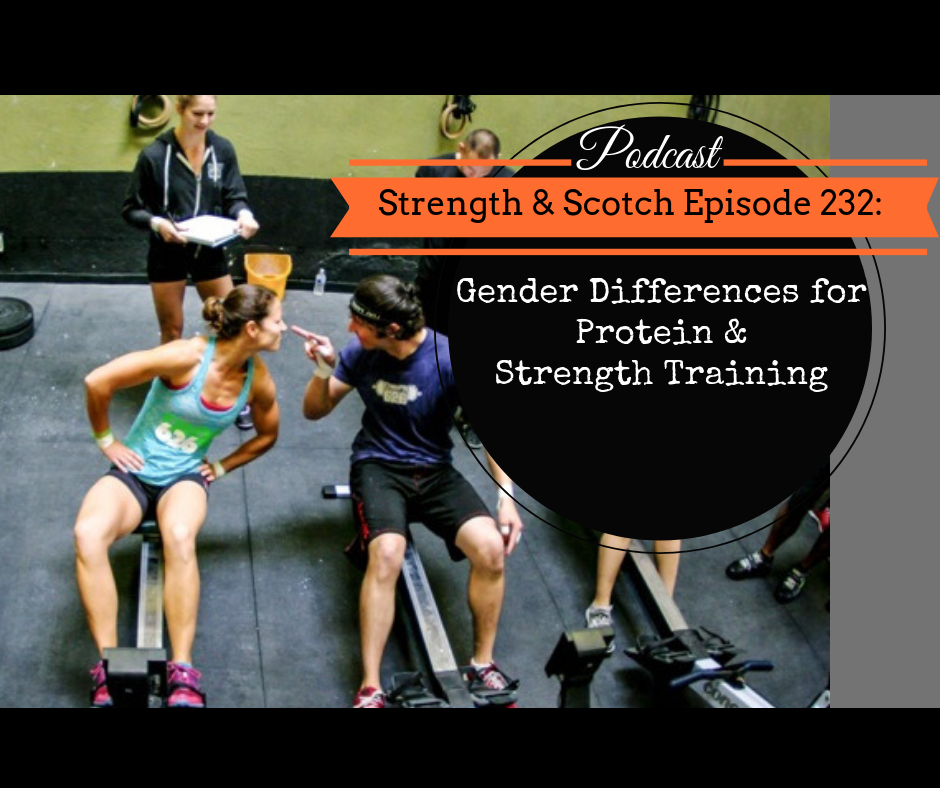Episode 232 Show Notes
Grant and Heavey take a look at some new studies about the differences between men and women in terms of protein and strength training.
[04:15] Studies on Women
Back on Episode 216, they talked on the gap in research on women where most scientific research is performed on male populations. This can be especially problematic when creating recommendations and distributing that information based upon those to women. For example, the original research on the role of estrogen for the prevention of heart disease was conducted on a large group of men. No women were included in the study. A large scale women study wasn’t conducted for another 30 years after that. The results of the newer study actually suggest that estrogen protocols based on the earlier men-based research may have caused harm in women over decades because of those inaccurate, unfounded recommendations.
[05:20] How Much Protein Do Women Need?
Heavey recently came across two papers targeting women or gender differences specifically on protein needs for women and their response to strength training.
Most athlete-specific protein recommendations that you’ll read that are research-based, tend to fall on the range of 1.3 to 2.2 g/kg body weight per day. At that high end, the 2.2 g/kg is equivalent to 1 g/lb. of body weight. So if you weigh 150 pounds, that would be 150 grams of protein per day. This is based on the “cover your ass” concept where everybody responds differently to protein. In the research of fit people trying to get the most out of their training, the 2.2 g/kg was safe across the board. However, this is based on the male population. So whether this is applicable to women, we don’t really know. That being said, Heavey presents some data that can help you make informed decisions.
[07:15] Studies Done on Women
The study looks at a relatively small number of women, specifically fit women. In order to qualify for the study, the women had to have been training for at least a year, doing whole body lifting protocols. They looked at 8 women in the study and felt this number was enough to look at the parameters they’re interested in. The one catch they used as an exclusion here too was that women can’t be on hormonal contraceptives to participate, with the idea that this could be affecting the results in some way. They required to be able to at least bench 70% of their body weight, leg press 230% of their body weight.
What they found from the study was that the average required intake for females to maximize full body protein synthesis was about 1.5 g/kg per day, with the safe intake level being 1.9 g/kg per day. This is a bit lower compared to the range for men.
[09:50] Women Have Less Muscle Mass… [Generally]
For a long time, the standard they’ve been using was nitrogen balance. Although recently, they’ve used indicator amino acid oxidation technique – considered the gold standard for determining protein needs.
As a whole, women have more fat mass than men. When they factored that in, the numbers fell back in line with the recommendation for men. Because women tend to have more fat mass and a higher body fat percentage, their protein needs tend to be lower because they have less muscle mass. Hence, our protein needs should be based more on our lean muscle mass.
The key takeaway here is to know that the 1 g/lb of body weight is fine but it’s probably more than women need unless you’re like an extremely lean woman. That said, you should not be compromising your gains in the gym whatsoever.
[14:23] Study on Strength Training
Another study Heavey found was designed to assess the influence of strength training on regional body comp across gender, and interestingly, race. They looked at 181 people in the study. Unfortunately, these were previously inactive individuals with an age group from 50-85. They were not smokers and free of major diseases. They compared Caucasian and African-American men and women. This was a 10-week program where they did unilateral knee extension training. They only trained one leg and they used the other leg as control.
The program was done three days per week, and doing 5 sets of 10 reps, specifically looking at the quads – the quad muscle volume, mid thigh, subcutaneous fat, intermuscular fat, and a cross-section. They measure all of those with some imaging techniques. They noticed that both men and women experienced muscle gain but it was significantly greater in men. Men weigh more than women and when they factored that in, on a percentage basis, the results were about the same.
The researchers asked them to not change their baseline physical activity outside of doing this exercise protocol. And they asked them to continue to eat the way they have been eating prior to starting the study as well. They found that the men increased their 1 rep max by 23.5% while the women increased this by 27.8%.
Moreover, what Heavey has found with a number of his clients is that women tend to respond to higher volume training better than men.
[20:40] Hear More from Heavey!
Check out Heavey’s monthly newsletter for a deep-dive on what he’s been researching. Just head to strengthandscotch.com/emailme.
Links:
Episode 216: Don’t Discriminate Against Fit Women

Check out the gear page for everything Strength & Scotch! You’ll find a listing of all the supplements and other programs we’ve discussed on the show as well as our killer t-shirts!

